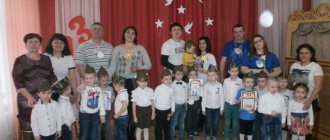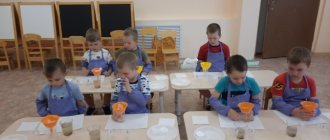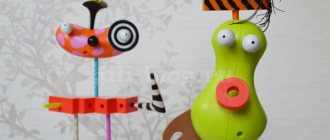A lump of salted dough - It’s interesting to sculpt from it! The dough ball is soft, pleasant and smooth to the touch. It’s lying in my palm, I can mold it into a cat, I can mold it into a baby elephant or a mouse, I can mold it into a picture that I saw in a book, I crushed the lump a little, I’ll mold it into arms and legs, I’ll mold it into ears and eyes, and together we’ll go to a fairy tale! I. Glebova
In the main general education program, the priority is the developmental function, which ensures the development of the child’s personality.
The state of the domestic preschool education system is currently characterized by a transition to new approaches focusing education on a humanistic, personality-oriented model. This significantly expands the range of educational tasks that can be solved.
One of the closest and most natural activities for a preschool child is visual arts and modeling. In the process of visual activity and modeling, preschoolers acquire a whole range of graphic and pictorial skills and abilities, learn to analyze objects and phenomena of the world around them. This activity develops fine motor skills of the fingers, their muscles, coordination of movements, has a beneficial effect on the development of speech (since the projection of the hand is in close proximity to the speech zone in the brain), relieves nervous tension, fear, and provides a positive emotional state. Fine art and modeling provide ample opportunities for experiencing beauty and for developing children’s emotional and aesthetic attitude to reality. Visual activities in kindergarten are an effective means of understanding reality. This activity helps the development and formation of visual perceptions, imagination, memory, spatial concepts, feelings and other mental processes. Such personality traits as perseverance, focus, accuracy, and hard work are formed. “All modern programs present three ways for preschool children to master the fine arts: perception - performance - creativity. Every child, in my deep conviction, should grow up from childhood in an atmosphere of love, beauty, and creativity. I try to turn joint activities with children with testoplasty into creativity, then real works of art will come out of his hands! While working with dough, I strive to develop in children aesthetic taste, a sense of rhythm, and the ability to understand beauty. While modeling from salt dough, children's vocabulary is activated, because during classes, I ask them to voice their actions. The child sculpts and explains: “The bear has such wide paws because...”. A child can fantasize and can share his knowledge about the world around him with other children. I develop logical thinking, just as before work a child, first of all, must consistently think through a plan of action, think through every detail: what? For what? Why? After completing the work, the children perform their craft, compose a fairy tale, and stage real theatrical performances. When planning my work with children, I use dramatization games (children create fairy tale characters and voice them). Learning to form is not on the basis of “doing according to instructions or a model,” which is what an adult suggests, but to “come up with” your own plans, formulate ideas and realize individual imaginations in activities. The content of the activity is structured in accordance with the thematic planning of the speech therapist, defectologist, and also based on the interests of the students. Children love to make crafts for the holidays (New Year's tiger, Christmas trees, fairy horseshoes); making homemade toys for kids; making heroes based on Russian folk tales; attributes for role-playing games: vegetables, fruits, bakery products to the store. I consider the collective panels to be the pride of the children - “The Seabed”, “Mysterious Space”, “Fruit Basket”.
To create a subject-development environment, I made a card index of games for the artistic and aesthetic development of children. I think the most interesting are “Guess and tell about a folk toy”, “Find out an element of a pattern”, “What does it look like?”, “Complete a craft”, “What doesn’t happen in the world?”, “Think and guess”, “Fantastic heroes”.
During activities, I try to ensure that children say the word “I can’t” as little as possible, I explain that we have gathered here to learn, that I will definitely help. By doing this, I remove the child’s fear that he will not succeed. Sometimes the word “I can’t” covers up the fact that the child does not want to study. Then it is necessary to create motivation in children, arouse interest and desire to study. To create motivation for activity, I use game techniques, through which I develop interest in testoplasty. Often, in order to interest children, I use “animation” and playing with crafts with which they can talk, consult and play. The content of game actions depends on the content of crafts. If it is a bird, then it can “fly”, “peck”, “talk”, “show off to each other”.
When sculpting circus animals, children were trainers and talked about their animals on their own; While playing a game of drawing up an identikit, children took on the role of a “detective” and came up with a positive and negative character, etc. By offering children a role, I arouse interest in the task and a desire to complete it. Acting in character, the child is passionate about his work, inventive, and does his work carefully. And I also take on some role - a sorceress of colors, a sorcerer or a grandmother - a riddle who has forgotten all the fairy tales and cannot tell them to the children.
In order to maintain interest, I used elements of theatricality, surprise moments, game characters (Pinocchio, Dunno, Luntik), and didactic games (for example, “game names”). In joint activities with testoplasty, I activate the child’s speech and replenish his vocabulary. (What are you sculpting now? What will you sculpt later? What kind of ears will you make for the bunny? Why did you give the bear such powerful, strong paws? What kind of mood will your hero have: sad, cheerful, perky, cunning?)
With the help of testoplasty, I tried to create conditions for the creative self-expression of pupils (modeling for a table theater, attributes for role-playing games “Home”, “Shop”; regular exhibitions of children's creativity in kindergarten, in the city children's library, in the library of the Michurinsky Village Council of the Iskitim region , in the museum of the city of Berdsk, etc.).
In my pedagogical activities, applying the principle of integration of learning, I develop the child’s thinking, his knowledge in the field of the formation of elementary concepts in mathematics, orientation in space (divide a piece of dough and count the parts, compare them by size, shape, which parts of the craft are in front, behind, left, right). I develop the child’s speech: I suggest talking about my craft, describing it, giving it a name, composing a story about its adventures. I use crafts in play activities: it is advisable that the child does not immediately take the craft home, but uses it in games for some time. In the group, we collected a collection so that we could show a tabletop theater for our peers. This makes children want to create new characters and develop the plot of a fairy tale or game.
The modeling technique is rich and varied, but at the same time accessible to small children. Modeling is the most tangible form of artistic creativity. The child not only sees what he created, but also touches it, picks it up and changes it as necessary. The main tool in sculpting is the hand. From this point of view, the modeling technique can be assessed as the most environmentally friendly.
To teach a child the technical skills of modeling and develop his fine motor skills, first I take the child’s hands in my own, let him feel the force of pressing on a lump of dough: when rolling the dough into a ball, a stick of varying widths and lengths. The muscles of the palm should be tense, the hands should be straight. Therefore, I suggest that the child roll out the dough on the board. We make all the details only by hand. I immediately teach my child to work carefully. Looking at the sample, children analyze the shape of the parts and their location. Then I remove the sample. Using my piece of dough, I demonstrate sculpting techniques: pulling, pinching, spreading, and others. After the show I put my work away. This is done to prevent the child from copying the product. If a child finds it difficult while working, I show him the required technique on my piece of dough. If independent work is going on, I do not interfere with the child’s work. I can only show you on my piece of dough how to correct the error. When working together, I can pick up a child’s product and, at his request, correct the craft. I teach children how to work with a stack. So that children gain experience and know which side can make a drawing on the dough, a hole, a slot, and cut off the required piece of dough.
I think it is necessary to start by creating conditions in the group - a small corner of creativity. In my group I posted: paints (watercolors, gouache),
colored pencils, felt-tip pens, crayons, wax crayons, various brushes, pieces of foam rubber, scissors, colored and velvet paper. Natural materials: cones, seeds and fruits of various plants, pebbles, nutshells, twigs, dried flowers, cotton wool, sticks, fabric, pieces of cellophane, remnants of woolen threads, plot pictures, postcards, glue, cardboard, buttons, beads, beads, and other waste material. All this is concentrated in different boxes, caskets, and special containers. In the creativity corner, I put on a monthly changing exhibition to introduce folk and applied arts. My main task is to create conditions and provide all this diversity for the creative imagination of children. I can say with confidence that every child finds what he needs to realize his idea.
With the help of dough crafts, communication developed (we visit each other, say polite words to each other); by playing out children's poems and songs with crafts, she instilled moral and ethical values.
The work I have begun has wide boundaries and possibilities, and requires continuation. Work in this direction confirms that artistic and aesthetic development takes shape and develops not only on the basis of productive activity (sculpting from salt dough), but also in the perception of a work of art, in play activities, in the formation of a holistic picture of the world - therefore, I see the prospects of my work the need to organize these activities accordingly and improve them. I plan to develop a program of circle activities on testoplasty.
How to make salt dough
In testoplasty, salt dough familiar to all young mothers is used. The composition of the modeling dough is very simple:
- 300 g flour
- 300 g salt
- 200 ml water
- 1 tbsp vegetable oil (optional)
Mix salt with flour and, stirring the mixture thoroughly, gradually add water. Experienced art therapists recommend using finely ground salt and adding a tablespoon of refined oil to the mixture to make the consistency more elastic. The unused portion of the dough can be stored in the refrigerator until the next session.
You can see how to prepare salt dough and what materials you will need for creativity in this detailed video tutorial:
How to sculpt from salt dough
Dough is an incredibly pliable material from which you can mold anything: from pots and animal figures to panels of various sizes. Therefore, crafts made from salt dough provide a huge scope for imagination, developing skills and creating wonderful things for decoration, games and gifts for each other.
To create the simplest dough products, it is enough to have a rolling pin and a board; for children over three years old and adults, you can stock up on culinary decor and use toothpicks to draw details.
For almost all dough crafts, the workpiece is usually a “sausage” or a “ball”. To create, for example, a little man, a ball is used for the head, and sausages are used to sculpt the body, arms and legs.
Complex shapes can be created from rolled out dough using templates and molds. You can decorate the product with ribbons, beads, leaves or braids made of dough or anything else of the child’s choice. And of course, a special stage is painting the resulting figure.
You can paint crafts made from salt dough with your own hands, both at the modeling stage, and while kneading the dough and after the product has completely dried.
And you can dry crafts made from salt dough at room temperature, in the oven at 50 degrees and in the microwave on the lowest defrost setting. Drying dough products, of course, will take time, but then such a gift will delight its creator and owner for a long time!
How to make casts from salt dough
An example of an art therapy lesson with children
Crafts made from dough can become an independent activity for children of preschool and primary school age. An activity can provide additional educational information, for example, by making an owl from salt dough, telling the child all the interesting facts about this bird. But the big advantage of testoplasty is that modeling itself brings tangible benefits, both to mental processes and psychologically harmonizing consciousness.
On the eve of March 8, I conducted such a lesson with my son. The topic was banal - preparing gifts for teachers with your own hands. Despite the fact that at first I had to persuade him to go sculpt, then I couldn’t stop him! So he went wild, creating crafts one better than the other)))
So we got these 8s with flowers and baskets with fruits and flowers.
As soon as our dough crafts are dry (and they dry in the oven at a low temperature and just in the room), we plan to glue magnetic tape to them so that they become a warm decoration for the refrigerator of our favorite teacher)))
In this video I showed our vision of modeling salt dough for the holiday of March 8:
The video below presents several more master classes on making crafts from salt dough:
Fridge magnets. Souvenirs for the holiday.
Salt dough hat
Fruit basket
How to make a souvenir with your own hands. Salt dough yurt
Testoplasty brings children a lot of pleasure and positive emotions from the creative process, helps them learn the necessary skills, develop aesthetic taste, correct the baby’s behavior and give them the opportunity for self-expression. For adults, it helps solve psychological problems and restore the joys of life.





